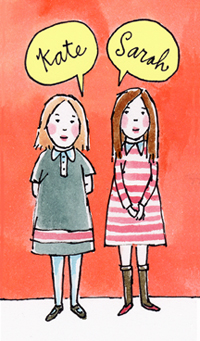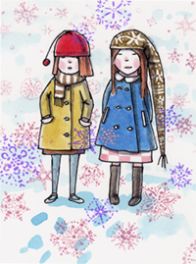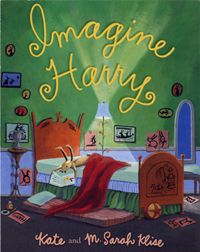
From paper dolls to valentines, Sarah and Kate Klise were constantly creating gifts for each other and their four other siblings during their childhood on Moss Avenue. The two middle sisters could be found working on school projects at St. Mark Grade School and Academy of Our Lady/Spalding Institute— from which they both graduated—as well as Marquette University in Milwaukee. They could also be found putting on ice-skating shows and summer plays or running chocolate candy and lemonade stands.
At the insistence of their mother, the two traded store-bought Halloween costumes for handmade papier mache masks. Instead of traditional Barbie accessories like plastic cars and dream houses, they invented uses for pipe cleaners and baskets. The cats in the Klise household also joined in their play, frequently parading around with blonde riders strapped to their backs. Elaborate games with steadfast rules and an invented language were dreamed up on long summer days over fallen apples, which were rounded up into piles of organic dodge balls. “It was completely outrageous and 100 percent fun. We loved it!” Kate said of the childhood games. “Then of course we’d go inside and complain to our mom that there was nothing to do at our house.”
The imagination well never ran dry for either of the sisters, who now direct their creative efforts into developing children’s books. Their fifth book in a series told through letters—Regarding the Bees: A Lesson, in Letters, on Honey, Dating, and Other Sticky Subjects—was published this month, and a children’s picture book, Imagine Harry—about a rabbit who has an imaginary friend— came out in June.
Their collaboration began in 1973, when Sarah was 11 and Kate was 10. As a Christmas gift for older sister Molly, Sarah illustrated a book which Kate wrote about a mouse. Drawing on inspiration from one of their favorite children’s books, E.B. White’s Stuart Little, Kate said that “the plot involved a mouse’s plan to travel around the country.” But their mouse had more of a devilish streak than Stuart, as it went around breaking into vending machines and stealing Cheetos and corn curls, which were forbidden in the Klise household. “It seemed worthy of this noble quest,” Kate joked of the mouse’s intentions. Their successful collaborative effort evolved over the following decade, with Sarah illustrating all but two of the 12 books Kate has written.
 The two are able to continue working together even though they aren’t under the same roof anymore and don’t even share the same state. Sarah lives in Berkeley, California, with her husband Byron and son Milo, and teaches art classes to youngsters in Chinatown. Kate lives in a small community in Norwood, Missouri and frequently travels all over the country as a roving reporter for People magazine. She also leads writing workshops for young writers, working with students in Connecticut, New Mexico, Ohio, Illinois and Missouri this past spring.
The two are able to continue working together even though they aren’t under the same roof anymore and don’t even share the same state. Sarah lives in Berkeley, California, with her husband Byron and son Milo, and teaches art classes to youngsters in Chinatown. Kate lives in a small community in Norwood, Missouri and frequently travels all over the country as a roving reporter for People magazine. She also leads writing workshops for young writers, working with students in Connecticut, New Mexico, Ohio, Illinois and Missouri this past spring.
The different settings suit the women well in their literary processes. “I love traveling, and I’m on the road a lot, either presenting at conferences or leading writing workshops or reporting for the magazine. But when I want to write, I have to be home in my little valley in the Missouri Ozarks,” Kate said. “I’ve become completely addicted to quiet, which, for me, is an essential element of writing. I need to be able to hear my characters and follow where they lead. I don’t write or think well with the distractions of a city. I don’t even have a TV at my house. I really love the stillness and quiet and the absolute night darkness I only find away from the bright lights and big city.”
Sarah, however, is drawn to the crazy mix of the city. “But really, I only want to partake (in the city) on a weekly basis,” Sarah said. “I have taught children painting and drawing in Chinatown on Saturdays for more than 20 years. They inspire me and really are the ones who taught me how to do what I do. As I did not attend art school, after college I felt adrift knowing that I wanted to make artwork, but also had to pay the rent. The Chinatown Young Art Program saved me. It has allowed me the time and place and community I needed to develop. The rest of the week I am home, working to the sound of the radio.”
For both sisters, the inspiration to write for children partially came from their large extended family of nieces and nephews. Kate says she’s also cursed with a memory that has cataloged every childhood experience—“from bad haircuts to school plays to loathsome winter coats.”
“I draw on that stuff, too,” Kate said. “Bruce Springsteen has a great line about if you’ve lived on this earth for 18 years, you have enough material to last a lifetime. Maybe relating to children just means remembering how complicated childhood really is.”
 Imagine Harry was actually based on Kate’s experiences with her imaginary friend, Charlie, who joined the family when Kate was about 4 years old. “It was the year Sarah went to kindergarten. I guess I was feeling a bit lonely,” Kate said. “Charlie turned out to be a great pal. He lived in my left wrist. We spent the year listening to records in the living room and roller skating in the basement while my mom ironed. She was always good about giving me an extra graham cracker for Charlie.”
Imagine Harry was actually based on Kate’s experiences with her imaginary friend, Charlie, who joined the family when Kate was about 4 years old. “It was the year Sarah went to kindergarten. I guess I was feeling a bit lonely,” Kate said. “Charlie turned out to be a great pal. He lived in my left wrist. We spent the year listening to records in the living room and roller skating in the basement while my mom ironed. She was always good about giving me an extra graham cracker for Charlie.”
Most of the subjects of the Klises’ books spring from personal memories or experiences, but their parents were also inspiration for the two women—exposing them to great literature and art at a young age. Their father, Thomas Klise, produced educational films and published a novel, The Last Western, in 1974. “It’s not as if my dad taught me how to write—though now that I think about it, I can still remember some of the editing advice he gave me on a paper I wrote in seventh grade,” Kate said. “But it’s probably more that I saw the process of a book being created: how long it takes; how you have to isolate yourself for long stretches of time; how cranky you can get when you’re reviewing the final proofs.”
After his death in 1978, their mother, Marjorie, took over as president of their educational production company. “It certainly helps to have role models who launched a business based on their interests and passions,” Sarah said. “It also helped that both our mother and father had wonderful taste in literature and art.”
The Peoria Public Library had a hand in their development as well. Every two weeks, the Klise sisters would visit the library, where Sarah would pour over books’ illustrations and trace Garth Williams’ drawings of Stuart Little. Kate would devour the text of Stuart Little, as well as everything else by E.B. White and Roald Dahl. These early influences are evident in the style of Sarah’s illustrations. Capturing a vintage and earthy feel, her drawings make use of warm colors and soft backgrounds and put the characters in cozy and comfortable settings.
“If you came to my house you’d see the same thing, same with our mother’s. Our grandmother, Margaret Costello, was a collector of sorts,” Sarah said. “We spent many Saturdays at auctions down in cold warehouses by the Illinois River or at estate sales wandering around someone else’s house. Our grandmother, who lived right down the street from us on Moss Avenue, had a wonderful attic and basement filled with treasures. So I suppose my illustrations are a composite of all that stuff. She and my mom taught us how to refinish furniture, cane chairs and sew. Maybe more importantly, they gave us a love for things that had some sense of history or place.”
Kate wants to capture text that puts the laughs back in language. The names of characters are one way Kate is able to evoke some humor—Tad Poll, Goldie Fisch, Fisher Cutbait and Anita Shawer. “I can already hear people groaning. But my feeling is this is a way to show young readers how flat out fun language can be. That’s something I hope children glean from our books. And if it takes puns to do that, so be it,” Kate said. In her non-graphic novels, Deliver Us from Normal and Far from Normal, set in Normal, Illinois, she aims to cultivate a deeper awareness of what growing up is all about—that it’s not always easy and that “the ability to be hurt and to feel other people’s pain is one measure of being a decent human being.” “I also riff on our national obsession with celebrity and reality TV in Far from Normal,” Kate said.
And fans are taking notice of their work, from various awards to letters from readers who tell Kate they’re working on the newest installation for the Regarding series. “That kind of gentle plagiarism is hugely flattering,” Kate said. Other youngsters claim that Sarah is the best artist in the whole world. “I would have written Garth Williams or William Pene DuBois and said the exact same thing,” Sarah added. “Books have this magical way with so many of us. They make you feel passionate. I love that.” TPW
For more information on the Klises’ and their books, visit www.kateandsarahklise.com.
